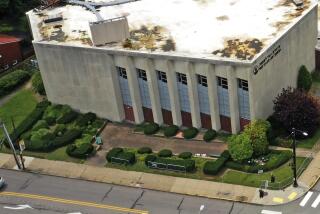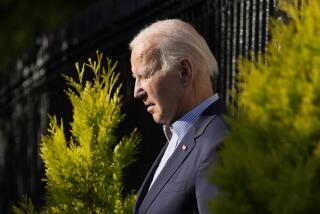World War II memorial moves toward reality : Officials have agreed on a prominent site on the National Mall. Fund raising is the next task for sponsors.
- Share via
WASHINGTON — Americans who toiled through World War II will get a special gift on Veterans Day, when President Clinton dedicates the site of a national World War II Memorial--the first ever to commemorate that war effort.
Five decades have come and gone since the war ended, and World War II veterans themselves had something do with the memorial’s delay, said Charles Atherton, secretary of the Commission of Fine Arts, one of the three bodies responsible for choosing the site for the monument.
“A monument was the last thing on their minds when they came back after the war,” he said. “They wanted to reap the fruits of the country they had defended.”
There was discussion about a memorial as American troops returned home in 1945, but nothing came together. Absent an official monument, the memorial to the Battle of Iwo Jima has served as something of a surrogate World War II monument.
Over the years, as memorials were built in Washington to the Vietnam and Korean wars, World War II veterans “have had time to sit around thinking about the war and they are realizing: ‘Hey, we fought too,’ ” Atherton said.
Most World War II veterans are now in their 70s and would like to see their efforts commemorated in their lifetimes. Congress granted authorization for the memorial in 1993.
The new memorial will be given a more prominent spot than any monument on the National Mall since the Lincoln Memorial opened in 1922. The location, between the Washington Monument and the Lincoln Memorial, represents the first addition in more than 70 years to the grand corridor of open space that stretches from the Capitol 2.1 miles west to the Potomac River. The Korean War and Vietnam War memorials are behind the lines of trees that flank the central corridor.
The location is itself a significant symbol. Although most planning officials emphasize that each war and memorial is equally valued in the national mind, said F. Haydn Williams--a member of the American Battle Monuments Commission, which also had a hand in choosing the site--the prominent site implies a sort of pecking order.
“In the same way that Washington signifies the Revolutionary War, the great defining moment of the 18th Century, and Lincoln the Civil War, the great defining moment of the 19th Century, World War II is the great defining moment of this century,” Williams said.
“If this monument is right on the Mall, citizens and visitors alike will see that America feels this is the most important event of the era,” he said. “The proportion and scale of the new monument will put the Vietnam and Korean monuments in better historical perspective.”
Even while supporting the site selection, planners have expressed concern about its place on the central axis between the Capitol and the Lincoln Memorial. Two of the three site selection agencies have expressed a desire to preserve aesthetically appealing sight lines down that corridor and have asked the monuments commission to make sure it will not become cluttered.
“You have to be awfully careful what you do in that site, on an axis like that,” Atherton said.
The monument--the design of which has yet to be finalized--will incorporate the Rainbow Pool, a small basin at the east end of the Mall’s long Reflecting Pool named for its powerful fountains that used to project misty rainbow sprays on sunny days. Williams said his commission has already decided that the monument will consist of twin structures flanking the Rainbow Pool and paralleling the Reflecting Pool, thus ensuring that it will not obstruct the basic corridor of the Mall. He emphasized, however, that he expects the new memorial to be treated as a full-fledged member of “the monumental core of Washington.”
The monument will be dedicated not just to veterans but to all who contributed to the U.S. war effort. One side of the monument could be dedicated to World War II veterans and the other side might honor the efforts on the home front, Williams suggested.
His commission is also considering the possibility of an underground addition.
The site search took nine months and discarded at least seven potential locations. As official sponsors of the project, the battle monuments commission now must begin the task of raising the $100 million needed for the project, Williams said.
Although some federal funding has already been directed to the memorial--and the monuments commission will be asking for more soon--the panel will look to private donors for at least some of the total cost, officials said.
Construction will start as soon as fund raising permits, and the monument could be completed as early as the year 2000.
The Rainbow Pool site is currently used as the staging area for the annual Fourth of July fireworks display and serves as a landing site for visiting dignitaries’ helicopters.
More to Read
Sign up for Essential California
The most important California stories and recommendations in your inbox every morning.
You may occasionally receive promotional content from the Los Angeles Times.













